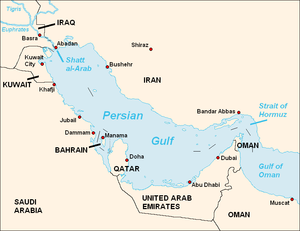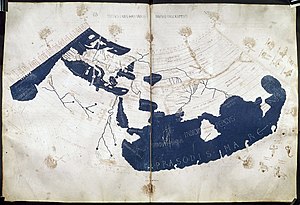Talk:Persian Gulf naming dispute/New version

The the body of water separating the Arabian Peninsula from the Iranian plateau is commonly known in English and several other languages as the the Persian Gulf after the land of Persia (Iran). Recently the mass usage of the name Arabian Gulf by some Arab countries since the 1960s have created an international controversy.[1] Rivalry between Persians and Arabs, along with the emergence of pan-Arabism and Arab nationalism, has seen the name Arabian Gulf become predominant in most Arab countries.[2][3] Names beyond these two have also been used both today and historically for this body of water.
Overview[edit]

Although this body of water is known by several different names in different cultures and languages, the most commonly used name throught most of history has been the "Persian Gulf". This reflects traditional usage since the Greek geographers Strabo and Ptolemy, and the geopolitical realities of the time with the Persian Empire (Iran) ruling the whole northern coastline and a scattering of local emirates on the Arabian coast. It was referred to as the Persian gulf in the Arabic Christian writer Agapius, writing in the 10th century.[4]
Arab countries also used the term "Persian Gulf" until the 1960s,[5][6][7][8] but with the rise of Arab nationalism during that decade, some Arab countries, including the ones bordering the Persian Gulf, adopted widespread use of the term "الخليج العربي" (al-Ḫalīj al-ʻArabiyy; Arab Gulf or Arabian Gulf) to refer to this waterway. This coupled with the decreasing influence of Iran on the political and economic priorities of the English-speaking Western World led to increasing acceptance, in regional politics and the mostly petroleum-related business, of the new alternative naming convention "Arabian Gulf" in Arab countries.
Historical Usage[edit]
The term "Arabian Gulf" (Sinus Arabicus) was formerly used to refer to what is now known as the Red Sea. This usage was adopted into European maps from, among others, Strabo and Ptolemy, who called the Red Sea Sinus Arabicus (Arabian Gulf). Both of these ancient geographers also used the name Sinus Persicus to refer to the body of water between the Arabian Peninsula and Iran. In the early Islamic era, Muslim geographers did the same, calling the body بحر فارس (Baḥr Fāris; Persian Sea) or "خليج فارس" (Ḫalīǧ Fāris; Persian Gulf). Later, most European maps from the early Modern Times onwards used similar terms (Sinus Persicus, Persischer Golf, Golfo di Persia and the like, in different languages) when referring to the Persian Gulf, possibly taking the name from the Islamic sources.
The capture of Baghdad by the Ottoman Empire in 1534 gave Turkey access to the Indian Ocean via the port of Basra at the head of the gulf. This coincided with the early mapmaking efforts of Gerard Mercator, whose 1541 terrestrial globe attempts to give the most up-to-date information, naming the gulf Sinus Persicus, nunc Mare de Balsera ("Persian Gulf, now Sea of Basra").[9] However, on his world map of 1569, the name is changed to Mare di Mesendin (after the peninsula Ra's Musandam, in modern-day Oman),[10] while his rival Abraham Ortelius, for the world atlas of 1570, opted for Mare El Catif, olim Sinus Persicus (after the Arabian port of Al Qatif), but labelled the entrance to the gulf- the present Strait of Hormuz- as Basora Fretum (Strait of Basra).[11] Among all this confusion, the old name gradually reasserted itself in the 17th century, but Turkey still uses the name "Gulf of Basra"[12] in Turkish today.
Following British attempts to control the seaway in the late 1830s, the Times Journal, published in London in 1840, referred to the Persian Gulf as the "Britain Sea," but this name was never used in any other context.[13]
Other names[edit]
Despite "Persian Gulf" being the most common name for this body of water, it carries different names around the world. In Turkey for example the name "Gulf of Basra" is commonly used, referring to the port of Basra in Iraq. Alternative names have also been suggested as a way to end the controversy between Iran and the Arab countries using the name "Arabian Gulf". After the Iranian Revolution of 1979 some people in Islamic groups suggested the use of "Islamic Gulf." The originator of the term Islamic Gulf is not known, while some people suggest that prominent figures of the early years of the Islamic republic including Ruhollah Khomeini, Mehdi Bazargan, and Sadegh Khalkhali may have supported the idea. The idea was quickly abandoned after Iran was invaded by its predominantly Arab and Muslim neighbor, Iraq.
The matter remains very contentious as the competing naming conventions are supported by certain governments in internal literature, but also in dealings with other states and international organizations. Some parties use terms like "The Gulf" or the "Arabo-Persian Gulf".
Viewpoint of Iran[edit]
Iran only uses the term "Persian Gulf" and does not recognize the naming when it is referred to as "Arabian Gulf" or just the "Gulf". Iran does not consider the latter an impartial usage, and views it as an active contribution to abandonment of the historical name.[14] Foreign airlines which do not use the term "Persian Gulf" are banned from Iran's airspace.[15][16]
The Islamic Republic of Iran designated April 30 as the "national day of Persian Gulf", since the date coincides with the anniversary of Shah Abbas' successful military campaign against the Portuguese navy in the Persian Gulf, driving the Portuguese colonial forces out of the Strait of Hormuz in the Capture of Ormuz (1622). .[17][18]
Viewpoint of third parties[edit]
United Nations[edit]
The Secretariat[edit]
The United Nations Secretariat on many occasions has requested its staff to use only "Persian Gulf" as the standard internal geographical designation for that body of water. Most recently, the UN Secretariat has issued two editorial directives in 1994 and 1999 mentioning that only the term "Persian Gulf" should be used in UN documents.[19][20][21]
Group of Experts on Geographical Names[edit]
The group of experts on Geographical Names was set up by the secretary-general of the United Nations in pursuance of economic and Social council resolution 715A(XXVII) on April 23, 1959 and has endorsed 'Persian Gulf' as the standard internal name for this body of water.[22]
The group discussed the naming issue during its 23rd session, held in Vienna from March 28 to April 4, 2006. According to the report of the meeting, the Convenor "noted that countries could not be prohibited from using or creating exonyms."[23]
International Hydrographic Organization[edit]
The International Hydrographic Organization, an international body for provision of hydrographic information for world-wide marine navigation and other purposes, uses the name "Gulf of Iran (Persian Gulf)" for this body of water. This is outlined in reference S-23 (Limits of Oceans and Seas), section 41.[24]
Atlas and other media[edit]
National Geographic Society uses the name Persian Gulf to refer to this body of water. In 2004, the society published a new edition of its National Geographic Atlas of the World using the term "Arabian Gulf" as an alternative name (in smaller type and in parentheses) for "Persian Gulf". This resulted in heavy protests by many Iranians, especially the Internet user community, which led to the Iranian government acting on the issue and banning the distribution of the society's publications in Iran. On December 30, 2004, the society reversed its decision and published an Atlas Update, removing the parenthetical reference and adding a note: "Historically and most commonly known as the Persian Gulf, this body of water is referred to by some as the Arabian Gulf."[25]
Some atlases and media outlets have taken to referring to "The Gulf" without any adjectival qualification. This usage is followed by the BBC and The Times Atlas of the World. Iran does not consider this an impartial usage and views it as an active contribution to abandonment of the historical name. In June 2006 Iran banned the sale of The Economist for the above reason, after a map in the magazine labeled the Persian Gulf as 'The Gulf'.[26] The Economist repeated this act in its February 18, 2010 article titled "Iraq, Iran and the politics of oil: Crude diplomacy". The Economist also used the name "Arabian Gulf" in the same article.
See also[edit]
Notes[edit]
- ^ Security Considerations in the Persian Gulf by Eilts, Hermann F. - International Security :Vol. 5, No. 2. (Autumn, 1980), pp. 79-113.
- ^ Asia Times - Asia's most trusted news source for the Middle East
- ^ Bosworth, C. Edmund. "The Nomenclature of the Persian Gulf." Pages xvii-xxxvi in Alvin J. Cottrell (ed.), The Persian Gulf States: A General Survey. Baltimore: Johns Hopkins University Press, 1980.) (pg xxxiii).. Excerpt: Not until the early 1960s does a major new development occur with the adoption by the Arab states bordering on the Gulf of the expression al-Khalij al-Arabi as weapon in the psychological war with Iran for political influence in the Gulf; but the story of these events belongs to a subsequent chapter on modern political and diplomatic history of the Gulf.
- ^ Agapius on a boat, retrieved 24 Feb. 2009.
- ^ ALAI, CYRUS. "GEOGRAPHY iv. Cartography of Persia". Encyclopædia Iranica. Retrieved 2012-02-01.:
.After World War II, some circles decided to change the name of the Persian Gulf to Arabian Gulf. Although the government of Persia opposed the move vehemently, in some editions of a few maps and atlases the term Persian was omitted, leaving only "The Gulf" (e.g., The Times Atlas, p. 39), while the historical term Persian Gulf mostly remained intact, as in the National Geographic Atlas (p. 77; fig. 7).
- ^ MILANI, MOHSEN M. "IRAQ vi. PAHLAVI PERIOD, 1921-79". Encyclopædia Iranica. Retrieved 2012-02-01.:
....Iraqi troops began to engage their Iranian counterparts in border skirmishes. Iraq once again called for “liberation” of the Khuzestan province from “Persian occupiers,” and began to use the term “Arabian Gulf,” rather than Persian Gulf...
- ^ Picture of Gamal Abdel Nasser's handwritten letter, using the term Persian Gulf
- ^ Picture of 1952 Saudi Arabian ARAMCO map using the name Persian Gulf
- ^ Gerard Mercator Terrestrial globe, Arabian section (1541) via harvard.edu
- ^ Gerard Mercator Mercator Projection world map (1569) via wilhelmkruecken.de
- ^ Abraham Ortelius Map of Turkish Empire (1570) via cartographicarts.com
- ^ Republic of Turkey Ministry of Culture and Tourism history page www.kultur.gov.tr
- ^ United Nations Group of Experts on Geographical Names Historical, Geographical and Legal Validity of the name 'Persian Gulf' (April 2006).
- ^ "Name game stokes U.S.-Iranian tensions - CNN.com". CNN. 24 January 2008. Retrieved 22 May 2010.
- ^ No Operation
- ^ Spencer, Richard (23 February 2010). "Iran threatens flight ban over 'Persian' Gulf name row". The Daily Telegraph. London. Retrieved 22 May 2010.
- ^ Iran names Persian Gulf national day, Retrieved on 26 February 2009.
- ^ Iranians to observe Persian Gulf Day, The Tehran Times, Retrieved on 30 April 2010.
- ^ "UN Editorial directive regarding the Persian Gulf".
- ^ "USE OF THE TERM "PERSIAN GULF"" (PDF).
- ^ "Use of the terms "Persian Gulf", "Gulf" and "Shatt al-Arab"" (PDF).
- ^ http://www.worldpress.org/Mideast/2616.cfm, http://www.un.org/depts/dhl/maplib/docs/escwa.pdf, http://www.un.org/Depts/Cartographic/map/profile/iran.pdf, http://www.un.org/Depts/Cartographic/map/profile/westasia.pdf
- ^ Report of the United Nations Group of Experts on Geographical Names on the work of its twenty-third session. Document E/2006/57, Economic and Social Council, United Nations. New York, 2006.[1]
- ^ "Limits of Oceans and Seas, 3rd edition" (PDF). International Hydrographic Organization. 1953. Retrieved 6 February 2010.
- ^ National Geographic Magazine - NGM.com
- ^ "Louvre's 'Gulf' Move Draws Iranian Ire". Radio Free Europe/Radio Liberty. 2006. Retrieved 18 December 2008.
{{cite news}}: Check date values in:|date=(help); Cite has empty unknown parameter:|curly=(help)
ar:الخلاف على اسم الخليج العربي de:Namensgebung des Persischen Golfes fa:تحریف نام خلیج فارس ja:ペルシア湾呼称問題 tr:Basra Körfezi adlandırma sorunu
